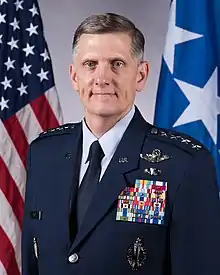List of active duty United States four-star officers
There are currently 45 active-duty four-star officers in the uniformed services of the United States: 18 in the Army, 3 in the Marine Corps, 9 in the Navy, 11 in the Air Force, 2 in the Space Force, 2 in the Coast Guard, and 0 in the Public Health Service Commissioned Corps. Of the eight federal uniformed services, the NOAA Commissioned Officer Corps is the only service that does not have an established four-star position.
List of designated four-star positions
Joint Chiefs of Staff
| Position insignia | Position | Photo | Incumbent | Service branch |
|---|---|---|---|---|
| Office of the Joint Staff | ||||
 |
Chairman of the Joint Chiefs of Staff (CJCS) |  |
General Mark A. Milley |
 U.S. Army |
 |
Vice Chairman of the Joint Chiefs of Staff (VJCS) | .jpg.webp) |
General John E. Hyten |
 U.S. Air Force |
Unified Combatant Commands
Other joint positions
| Position insignia | Position | Photo | Incumbent | Service branch |
|---|---|---|---|---|
| National Guard | ||||
 |
Chief of the National Guard Bureau (CNGB) | 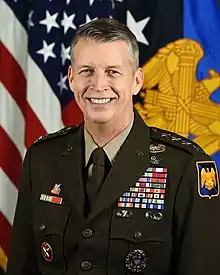 |
General Daniel R. Hokanson |
 U.S. Army |
| Sub-unified combatant commands | ||||
 |
Afghanistan Commander, Resolute Support Mission (RS) and Commander, U.S. Forces - Afghanistan (USFOR-A) |
 |
General Austin S. Miller |
 U.S. Army |
 |
Korea Commander, United Nations Command (UNC), Commander, R.O.K.-U.S. Combined Forces Command (CFC) and Commander, U.S. Forces Korea (USFK) |
 |
General Robert B. Abrams |
 U.S. Army |
| Special activities | ||||
 |
Chief Operating Officer, Operation Warp Speed (OWS) | 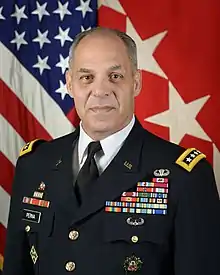 |
General Gustave F. Perna |
 U.S. Army |
United States Army
| Position insignia | Position | Photo | Incumbent | Service branch |
|---|---|---|---|---|
| Army staff | ||||
 |
Chief of Staff of the Army (CSA) |  |
General James C. McConville |
 U.S. Army |
 |
Vice Chief of Staff of the Army (VCSA) | .jpg.webp) |
General Joseph M. Martin |
 U.S. Army |
| Army commands | ||||
 |
Commanding General, U.S. Army Forces Command (FORSCOM) | 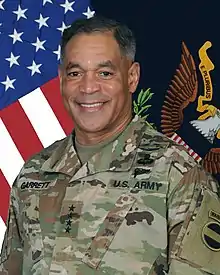 |
General Michael X. Garrett |
 U.S. Army |
 |
Commanding General, U.S. Army Futures Command (AFC) |  |
General John M. Murray |
 U.S. Army |
 |
Commanding General, U.S. Army Materiel Command (AMC) |  |
General Edward M. Daly |
 U.S. Army |
 |
Commanding General, U.S. Army Training and Doctrine Command (TRADOC) |  |
General Paul E. Funk II |
 U.S. Army |
| Army service component commands | ||||
 |
Commanding General, U.S. Army Europe and Africa (USAREUR-AF) | .jpg.webp) |
General Christopher G. Cavoli |
 U.S. Army |
 |
Commanding General, U.S. Army Pacific (USARPAC) |  |
General Paul J. LaCamera |
 U.S. Army |
United States Marine Corps
| Position insignia | Position | Photo | Incumbent | Service branch |
|---|---|---|---|---|
| Headquarters Marine Corps | ||||
 |
Commandant of the Marine Corps (CMC) |  |
General David H. Berger |
 U.S. Marine Corps |
 |
Assistant Commandant of the Marine Corps (ACMC) |  |
General Gary L. Thomas |
 U.S. Marine Corps |
United States Navy
| Position insignia | Position | Photo | Incumbent | Service branch |
|---|---|---|---|---|
| Office of the Chief of Naval Operations | ||||
 |
Chief of Naval Operations (CNO) |  |
Admiral Michael M. Gilday |
 U.S. Navy |
 |
Vice Chief of Naval Operations (VCNO) |  |
Admiral William K. Lescher |
 U.S. Navy |
 |
Director, Naval Nuclear Propulsion Program[1] and Deputy Administrator, NNSA's Naval Reactors[2] |
 |
Admiral James F. Caldwell Jr. |
 U.S. Navy |
| Operating forces | ||||
 |
Commander, U.S. Fleet Forces Command (USFF), Commander, U.S. Naval Forces Northern Command (U.S. Navy North), Commander, U.S. Naval Forces Strategic Command (NAVSTRAT) and Joint Force Maritime Component Commander (JFMCC) |
 |
Admiral Christopher W. Grady |
 U.S. Navy |
 |
Commander, U.S. Naval Forces Europe-Africa (CNE-CNA) and Commander, Allied Joint Force Command Naples (JFC Naples) |  |
Admiral Robert P. Burke |
 U.S. Navy |
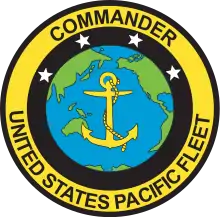 |
Commander, U.S. Pacific Fleet (USPACFLT) |  |
Admiral John C. Aquilino |
 U.S. Navy |
United States Air Force
United States Space Force
| Position insignia | Position | Photo | Incumbent | Service branch |
|---|---|---|---|---|
| Office of the Chief of Space Operations | ||||
 |
Chief of Space Operations (CSO) |  |
General John W. Raymond |
 U.S. Space Force |
 |
Vice Chief of Space Operations (VCSO) |  |
General David D. Thompson |
 U.S. Space Force |
United States Coast Guard
| Position insignia | Position | Photo | Incumbent | Service branch |
|---|---|---|---|---|
| Office of the Commandant | ||||
 |
Commandant of the Coast Guard |  |
Admiral Karl L. Schultz |
 U.S. Coast Guard |
 |
Vice Commandant of the Coast Guard |  |
Admiral Charles W. Ray |
 U.S. Coast Guard |
United States Public Health Service Commissioned Corps
| Position insignia | Position | Photo | Incumbent | Service branch |
|---|---|---|---|---|
| Office of the Assistant Secretary for Health | ||||
 |
Assistant Secretary for Health (ASH)[3] |  |
Vacant | |
List of pending appointments
| Position insignia | Designated position | Photo | Name | Service branch | Status and date |
|---|---|---|---|---|---|
 |
Commanding General, U.S. Army Pacific (USARPAC) | .jpg.webp) |
Lieutenant General Charles A. Flynn |
 U.S. Army |
Confirmed by the Senate December 20, 2020[4][5] |
Statutory limits
The U.S. Code explicitly limits the total number of four-star officers that may be on active duty at any given time. The total number of active-duty general or flag officers is capped at 231 for the Army, 162 for the Navy, 198 for the Air Force, and 62 for the Marine Corps.[6] For the Army, Marine Corps, Navy and Air Force, no more than about 21%[7] of each service's active-duty general or flag officers may have more than two stars,[8] and statute sets the total number of four-star officers allowed in each service.[8] This is set at 7 four-star Army generals,[8] 6 four-star Navy admirals,[8] 9 four-star Air Force generals,[8] 2 four-star Marine generals[8] and 2 four-star Space Force generals.
Several of these slots are reserved by statute. For the Army and the Air Force, the Chief of Staff and the Vice Chief of Staff for both services are all four-star generals; for the Navy, the Chief and Vice Chief of Naval Operations are both four-star admirals; for the Marine Corps, the Commandant and the Assistant Commandant are both four-star generals. For the Space Force, the Chief of Space Operations and the Vice Chief of Space Operations are both four-star generals.[9] For the Coast Guard, the Commandant[10] and the Vice Commandant[11][12] are both four-star admirals. For the National Guard, the Chief of the National Guard Bureau[13] is a four-star general under reserve active duty in the Army or Air Force. And for the Public Health Service Commissioned Corps, the Assistant Secretary for Health[14] is a four-star admiral if he or she holds an active-duty appointment to the regular corps.
Exceptions
There are several exceptions to the limits allowing more than allotted four-star officers within the statute. A four-star officer serving as Chairman[15] or Vice Chairman of the Joint Chiefs of Staff[15] does not count against his or her service's general- or flag-officer cap. An officer serving as Chief of the National Guard Bureau[16] does not count against his or her service's general-officer cap. The Secretary of Defense can designate no more than 20 additional four-star officers,[6] who do not count against any service's general- or flag-officer limit,[6] to serve in one of several joint positions. These positions include the commander of a unified combatant command[17] and the commander of U.S. Forces Korea.[17] Officers serving in certain intelligence positions are not counted against statutory limit, including the Director of the Central Intelligence Agency.[18] The President may also add up to 5 four-star slots to one service if they are offset by removing an equivalent number from other services.[8] Finally, all statutory limits may be waived at the President's discretion during time of war or national emergency.[19]
On September 14, 2001, the President declared a national emergency and invoked his authority to waive all statutory limits on the number and grade distribution of general and flag officers on active duty.[20] On this basis, a number of senior officers in the Middle East have been appointed in excess of the normal limits, including the four-star commanders of the Afghanistan and Iraq theaters, and the temporary authorization for their positions will expire shortly following the termination of the national emergency.
Appointment
Four-star grades go hand-in-hand with the positions of office they are linked to, so these ranks are temporary. Officers may only achieve four-star grade if they are appointed to positions of office that require and/or allow the officer to hold such a rank.[21] Their rank expires with the expiration of their term of office, which is usually set by statute.[21] Four-star officers are nominated for appointment by the President from any eligible officers holding a one-star grade or above, who also meets the other requirements for the position, under the advice and/or suggestion of their respective executive department secretary, service secretary, and if applicable the joint chiefs.[21] The nominee must be confirmed via majority by the Senate before the appointee can take office and thus assume the rank.[21]
It is extremely unusual for a four-star nominee to draw even token opposition in a Senate vote, either in committee or on the floor, because the administration usually withdraws or declines to submit nominations that draw controversy before or during the confirmation process.
- For example, upon encountering opposition in the Senate, the administration declined to submit nominations for General Joseph W. Ralston to be chairman of the Joint Chiefs of Staff in 1997.[22]
- Lieutenant General Ricardo S. Sanchez was once the leading candidate to become commander of U.S. Southern Command in 2004.[23]
- General Peter Pace would have faced tough scrutiny from the Senate over the wars in Iraq and Afghanistan had he been nominated for reappointment as chairman of the Joint Chiefs of Staff in 2007.[24]
- The President withdrew the nominations of Admiral Stanley R. Arthur to be commander in chief of U.S. Pacific Command in 1994,[25] and of General Gregory S. Martin to be commander of U.S. Pacific Command in 2004[26] over their handling of the Tailhook and Darleen Druyun scandals respectively.
When a doomed nomination is not withdrawn, the Senate typically does not hold a vote to reject the candidate, but instead allows the nomination to expire without action at the end of the legislative session.
- For example, the Senate declined to schedule a vote for the nomination of Lieutenant General James A. Abrahamson to be elevated to four-star rank as director of the Strategic Defense Initiative Organization in 1986.[27]
- The Senate also declined to vote on Lieutenant General Charles W. Bagnal's nomination for four-star rank and as commanding general of U.S. Army Pacific in 1989.
- Major General John D. Lavelle was nominated to be posthumously restored to four-star rank on the retired list in 2010, but the nomination also expired in the Senate without action.[28]
- And Rear Admiral Cristina V. Beato was nominated to be assistant secretary for health in 2003 but her nomination also was not placed on the Senate schedule for a vote.[29] Had Beato been confirmed and assumed office, she would have been the first woman in any uniformed service to achieve four-star grade; instead that honor went to General Ann E. Dunwoody.
Tour length
The standard tour length for most four-star positions is three years, bundled as a two-year term plus a one-year extension, with the following exceptions:
- The Chairman of the Joint Chiefs of Staff serves for a nominal four-year term.
- The Vice Chairman of the Joint Chiefs of Staff serve for a nominal two-year term of office but may serve for up to six years, in three consecutive terms. The President can appoint them to serve a fourth term, for a combined total of eight years, if it serves in the interest of the nation. Typically, the vice chairman serves for four years.
- Service chiefs of staff serve a nominal four-year term.
- The Commandant of the Coast Guard serves for a nominal four-year term.
- The Chief of the National Guard Bureau serves a nominal four-year term.
- The Director of Naval Nuclear Propulsion serves for a nominal eight-year term.[30]
- The Assistant Secretary for Health is a civilian or a Public Health Service officer who serves for a nominal four-year term.
All appointees serve at the pleasure of the President. Extensions of the standard tour length can be approved, within statutory limits, by their respective service secretaries, the Secretary of Defense, the President, and/or Congress but these are rare, as they block other officers from being promoted. Some statutory limits of tour length under the U.S. Code can be waived in times of national emergency or war.[31][32] Four-star ranks may also be given by act of Congress but this is extremely rare.
Retirement
Other than voluntary retirement, statute sets a number of mandates for retirement. Four-star officers must retire after 40 years of commissioned service unless reappointed to grade to serve longer.[33] Four-star officers serving in the reserve active duty must retire after five years in grade or 40 years of commissioned service, whichever is later, unless reappointed to grade to serve longer.[34] Otherwise all general and flag officers must retire the month after their 64th birthday.[35] However, the Secretary of Defense can defer a four-star officer's retirement until the officer's 66th birthday[35] and the President can defer it until the officer's 68th birthday.[35] Officers that served several years in the enlisted ranks prior to receiving their commission typically don't make it to the 40 years in commission mark, because they are still subject to the age restrictions for retirement.
- For example, Admiral Michael G. Mullen was born on October 4, 1946; placed on active duty in 1968 and promoted to admiral on August 23, 2003. Ordinarily, he would have been expected to retire at the end of his four-year term as chief of naval operations in 2008 after 40 years of service. Instead, he was reappointed as an admiral and appointed as chairman of the Joint Chiefs of Staff on October 1, 2007. He retired from the Navy after serving two, two-year terms as chairman on October 1, 2011, at the age of 65 with 43 years of service and eight years in grade.
- General James F. Amos was born on November 12, 1946; placed on active duty in 1970 and promoted to general on July 3, 2008. Ordinarily, he would have been expected to retire at the end of his two-year term as assistant commandant of the Marine Corps in 2010 after 40 years of service. Instead, he was reappointed as a general and appointed as commandant of the Marine Corps on October 22, 2010. He retired from the Marine Corps after completing his four-year term as commandant on October 17, 2014, at the age of 67 with 44 years of service and six years in grade.
- General Frank J. Grass was born on May 19, 1951; enlisted in the Missouri Army National Guard in October 1969 and received his commission in 1981. He was appointed as a general in the active duty reserves and assignment as chief of the National Guard Bureau on September 7, 2012. He remained on reserve active duty until he completed of his four-year term as chief and retired from the Army on August 3, 2016, at 65 years of age with 35 years in commissioned service, 47 years of total service, and four years in grade.
Senior officers typically retire well in advance of the statutory age and service limits, so as not to impede the upward career mobility of their juniors. Since there are a finite number of four-star slots available to each service, typically one officer must leave office before another can be promoted.[36] Maintaining a four-star rank is like a game of musical chairs; once an officer vacates a position bearing that rank, he or she has no more than 60 days to be appointed or reappointed to a position of equal or greater importance before he or she must involuntarily retire.[21] Historically, officers leaving four-star positions were allowed to revert to their permanent two-star ranks to mark time in lesser jobs until statutory retirement, but now such officers are expected to retire immediately to avoid obstructing the promotion flow.
- For example, Vice Admiral Patrick M. Walsh was promoted to admiral and appointed as vice chief of naval operations in 2007. The incumbent vice chief, Admiral Robert F. Willard, was appointed as commander of the U.S. Pacific Fleet. The incumbent Pacific Fleet commander, Admiral Gary Roughead, was appointed as commander of U.S. Fleet Forces Command, whose incumbent commander, Admiral John B. Nathman, received no further appointment and retired at the age of 59, with 37 years of service and three years in grade.
- Lieutenant General Gary L. North was promoted to general and appointed as commander of Pacific Air Forces in 2009. The incumbent Pacific Air Forces commander, General Carrol Chandler, was appointed as vice chief of staff of the air force, while the incumbent vice chief, General William M. Fraser III, was appointed as commander of Air Combat Command, whose incumbent commander, General John D. W. Corley, received no further appointment and retired at the age of 58, with 36 years of service and four years in grade.
To retire at four-star grade, an officer must accumulate at least three years of satisfactory active-duty service in that grade, as determined by his or her service secretary.[37] The President and Congress must also receive certification by either the Under Secretary of Defense for Personnel and Readiness, the Deputy Under Secretary of Defense for Personnel and Readiness, or the Secretary of Defense that the retiree served satisfactorily in grade.[37] The Secretary of Defense may reduce this requirement to two years, but only if the officer is not being investigated for misconduct.[38] The President may also reduce these requirements even further, or waive the requirements altogether, if he so chooses.[37][38] Four-star officers who do not meet the service-in-grade requirement will revert to the next highest grade in which they served satisfactorily for at least six months which is normally the three-star grade.[37] Since three-star ranks are also temporary, if the retiree is also not certified by the Secretary of Defense or the President to retire as a three-star, the retiree will retire at the last permanent rank he or she satisfactorily held for six months.[37] The retiree may also be subject to congressional approval by the Senate before the retiree can retire in grade.[39] It is extraordinarily rare for a four-star officer not to be certified to retire in grade or for the Senate to seek final approval.
- For example, when removed from office after less than the statutory time in grade, Generals Frederick F. Woerner and Stanley A. McChrystal were retired as full generals as certified by the President and were not subjected to senatorial confirmation.
- Admirals Husband E. Kimmel and Richard C. Macke were not certified to retire at three-star or four-star rank, and retired as two-star rear admirals.[40]
- General Kevin P. Byrnes had over two years in grade but was being investigated for misconduct, and retired as a lieutenant general.[41]
- In 1972 General John D. Lavelle was relieved for misconduct and certified to retire as a lieutenant general, but was rejected by a Senate Armed Services Committee vote of 14 to 2 and retired as a major general; in 2010 he was nominated posthumously for advancement to general on the retired list based on newly declassified evidence,[42] however as stated above, the Senate did not vote on the nomination and let it expire at the end of the Congressional session.[28]
- General Michael J. Dugan retired as a full general as certified by the President, but only after receiving approval from the Senate Armed Services Committee.[43]
- After achieving the statutory time in grade, Admirals Frank B. Kelso II and Henry H. Mauz Jr. were retired as full admirals, but only after going through a full senatorial confirmation vote of 54 to 43[44] and 92 to 6,[45] respectively.
Four-star officers who are under investigation for misconduct typically are not allowed to retire until the investigation completes, so that the Secretary of Defense can decide whether to certify that their performance was satisfactory enough to retire in their highest grade.[37][46]
- For example, an investigation by the Department of Defense comptroller held Generals Roger A. Brady and Stephen R. Lorenz in their four-star commands for up to 13 months beyond their originally scheduled retirements.[47]
- General William E. Ward relinquished his four-star command as scheduled, he remained on active duty in his permanent grade of major general, pending an investigation by the Department of Defense inspector general[46] before being allowed to retire as a lieutenant general over a year after his original scheduled retirement.[48]
- Admiral Samuel J. Locklear was held in his four-star command for months beyond his original scheduled retirement by the Navy's Consolidated Disposition Authority, while under investigation for the Fat Leonard corruption scandal before being cleared of any wrongdoing.[49]
Furthermore, retired four-star officers may still be subjected to the Uniform Code of Military Justice and disciplinary action, including reduction in retirement rank, by the Secretary of Defense or the President if they are deemed to have served unsatisfactorily in rank, post their retirement.[50]
- General David H. Petraeus, who had retired from the Army as a four-star general on August 31, 2011, faced punitive action from the Secretary of Defense, over four years past his retirement date, for mishandling classified materials while serving as the commander of the International Security Assistance Force and U.S. Forces Afghanistan.[51] He was allowed to retain his four-star rank in retirement with the recommendation of the Secretary of the Army[50] and strong support from ranking members of the Senate Armed Services Committee.[52]
- General Arthur Lichte, who had retired from the Air Force as a four-star general on January 1, 2010, received a letter of reprimand from the secretary of the Air Force, for sexually assaulting a subordinate female officer on multiple occasions, over six years after his retirement date.[53] The Secretary of Defense withdrew Lichte's certification of satisfactory service,[54] and reduced his retirement rank to major general,[54] which the Air Force determined was his last permanent rank he served in satisfactorily.[54] Lichte could have faced charges under the Uniform Code of Military Justice, however since the allegations were not reported or investigated until over five years past when they occurred, the statute of limitations bars having charges being brought up for prosecution.[53]
Four-star officers typically step down from their posts up to 60 days in advance of their official retirement dates. Officers retire on the first day of the month, so once a retirement month has been selected, the relief and retirement ceremonies are scheduled by counting backwards from that date by the number of days of accumulated leave remaining to the retiring officer. During this period, termed transition leave or terminal leave, the officer is considered to be awaiting retirement but still on active duty.
- For example, General Michael Hagee was relieved as commandant of the Marine Corps on November 13, 2006, and held his retirement ceremony the same day, but remained on active duty until his official retirement date on January 1, 2007.
A statutory limit can be waived by the President with the consent of Congress if it serves national interest. However, this is extremely rare.
- For example, the record for the longest tenure in any service is held by General Lewis B. Hershey who enlisted in the Indiana Army National Guard in 1911 at the age of 18. He was called up for federal active duty during World War I, receiving a commission in 1916, and subsequently transferred to the regular army at the end of the war. He served in active duty in the Army until the age of 80 before being involuntarily retired in 1973 after 62 years of continuous service.
- Admiral Hyman G. Rickover is listed as serving for 63 years in the Navy from 1918 to 1982. However his service reflects a time when attending any military academy was considered active duty service due in part from World War I. In today's military rules and regulations, an officer who initially begins their career through a military academy does not begin their service until upon receiving their commission after graduation, even though they are subjected to the Uniform Code of Military Justice while attending the academy.
See also
- List of United States military leaders by rank
- List of United States Army four-star generals
- List of United States Marine Corps four-star generals
- List of United States Navy four-star admirals
- List of United States Air Force four-star generals
- List of United States Space Force four-star generals
- List of United States Coast Guard four-star admirals
- List of United States Public Health Service Commissioned Corps four-star admirals
- Staff (military)
Notes
- Historically, the Director of Naval Nuclear Propulsion Program is held by an officer in the Navy, however 50 U.S.C. §2511 - Ex. Ord. No. 12344 states a civilian can be appointed to that position without joining or being a serving member of the Navy.
- By statute, 50 U.S.C. § 2406, any person serving as Director, Naval Nuclear Propulsion Program also concurrently serves as the National Nuclear Security Administration's Deputy Administrator, Naval Reactors.
- The position of Assistant Secretary of Health has historically been held by either a civilian or a uniformed officer of the Public Health Service Commissioned Corps.
- "PN2368 - Lt. Gen. Charles A. Flynn - Army, 116th Congress (2019-2020)". www.congress.gov. 2020-12-20. Retrieved 2020-12-21.
- "General Officer Assignments". U.S. DEPARTMENT OF DEFENSE. Retrieved 2021-01-26.
- Dividing the total number of general and flag officers above two stars (138) from the total number of general and flag officers overall (653) is 21.13%.
- 10 USC 525. Distribution of commissioned officers on active duty in general officer and flag officer grades.
- 10 U.S.C. § 9082 - Chief of Space Operations
- 14 USC 44. Commandant; appointment.
- 14 USC 47. Vice commandant; appointment.
- Pub.L. 114–120 (text) (pdf) - Coast Guard Authorization Act of 2015
- 10 USC 10502 Chief of the National Guard Bureau: appointment; adviser on National Guard matters; grade; succession.
- 42 USC 207. Grades, ranks, and titles of commissioned corps.
- 10 USC 664. Length of joint duty assignments
- 10 U.S. Code § 10502 - Chief of the National Guard Bureau: appointment; adviser on National Guard matters; grade; succession
- 10 USC 604. Senior joint officer positions: recommendations to the Secretary of Defense.
- 10 USC 528. Officers serving in certain intelligence positions: military status; exclusion from distribution and strength limitations; pay and allowances.
- 10 USC 527. Authority to suspend sections 523, 525, and 526.
- Proclamation 7463 of September 14, 2001. Declaration of national emergency by reason of certain terrorist attacks.
- 10 USC 601. Positions of importance and responsibility: generals and lieutenant generals; admirals and vice admirals.
- Henneberger, Melinda; Becker, Elizabeth (August 4, 1999), "For a Scandal-Scarred General, the Gleam Appears to Be Back on the Brass", The New York Times
- Hendren, John (October 15, 2004), "4-Star Plans After Abu Ghraib", Los Angeles Times, p. A-1
- Shanker, Thom (June 9, 2007), "Chairman of Joint Chiefs Will Not Be Reappointed", The New York Times
- "Clinton Selects Admiral to Lead Forces in Pacific", Associated Press, July 2, 1994
- Kakesako, Gregg K. (October 7, 2004), "General pulls plug on Camp Smith job", Honolulu Star-Bulletin
- Gordon, Michael R. (September 28, 1988), "General Quitting As Project Chief For Missile Shield", The New York Times
- Zucchino, David (December 23, 2010), "Fight to vindicate general dies in the Senate", Los Angeles Times
- Connolly, Ceci (June 10, 2004), "Top Health Official Awaits Hearing on Nomination", The Washington Post, p. A17
- 50 USC §2511. Naval Nuclear Propulsion Program - Ex. Ord. No. 12344
- 10 USC 152. Chairman: appointment; grade and rank
- 10 USC 154. Vice Chairman
- 10 USC 636. Retirement for years of service: regular officers in grades above brigadier general and rear admiral (lower half).
- 10 USC 14508 (d). Removal from the reserve active-status list for years of service: reserve general and flag officers
- 10 USC 1253. Age 64: regular commissioned officers in general and flag officer grades; exception
- DoD News Briefing on Thursday, June 6, 1996. Retirement of Admiral Leighton W. Smith Jr.
- 10 USC 1370. Commissioned officers: general rule; exceptions
- Gearan, Anne (June 28, 2010), "Cashiered general tells Army he'll retire", Associated Press via The Washington Post
- The U.S. Constitution gives Congress oversight over retirement of military personnel if they so choose.
- Kakesako, Gregg K. (April 9, 1996), "Macke still paying for rape remark", Honolulu Star-Bulletin
- Congressional Record, October 18, 2005 - H8917. Executive communications, etc.
- Casey, Aloysius; Casey, Patrick (February 2007), "Lavelle, Nixon, and the White House Tapes", Air Force Magazine, 90 (2); Office of the Assistant Secretary of Defense (Public Affairs) (August 4, 2010), Lavelle Posthumously Nominated to General, U.S. Department of Defense, archived from the original on August 28, 2010
- Senate panel opposes increase in fired Air Force chief's pension
- Admiral Frank Kelso's Senate confirmation vote for retirement
- Admiral Henry Mauz's Senate confirmation vote for retirement
- Vandiver, John (May 28, 2012), "Former AFRICOM chief Ward still on active duty pending probe", Stars and Stripes
- Rolfsen, Bruce (December 31, 2010), "Brass sanctions 'unprecedented'", Air Force Times
- Miles, Donna (November 14, 2012), "Panetta: Ward Ruling Recognizes High Standard for Leaders", American Forces Press Service via Defense.gov
- Cavas, Christopher P. (March 29, 2015). "PACOM Chief Locklear To Be Cleared in 'Fat Leonard' Probe". Defense News. Retrieved May 30, 2015.
- Craig Whitlock and, Adam Goldman (December 7, 2015). "Army recommends no further punishment for Petraeus". Washington Post. Retrieved January 26, 2016.
- Goldman, Adam (January 25, 2016). "How David Petraeus avoided felony charges and possible prison time". Washington Post. Retrieved January 26, 2016.
- Craig Whitlock and, Adam Goldman (January 30, 2016). "Pentagon won't punish David Petraeus any further in sex-and-secrets scandal". Washington Post. Retrieved February 5, 2016.
- Pawlyk and, Oriana (February 1, 2017). "Retired General Demoted 2 Ranks After Sexual Assault Investigation". Military.com. Retrieved February 2, 2017.
- Vanden Brook and, Tom (February 1, 2017). "Air Force busts retired four-star general down two ranks for coerced sex". USA Today. Retrieved February 2, 2017.


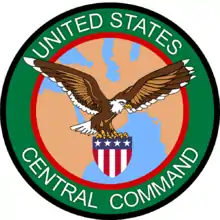
.jpg.webp)

.jpg.webp)















.jpg.webp)







